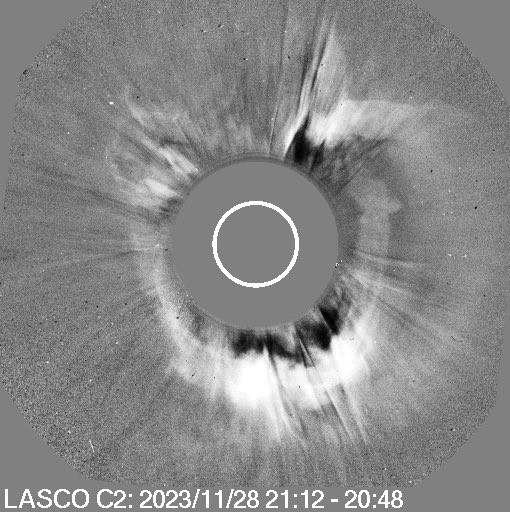Geomagnetic storm forecast - 29th November 2023
What Has Happened?
Several Coronal mass ejections (CMEs) left the Sun on 27th and 28th November and are expected to increase geomagnetic activity during 30th Nov and 1st Dec.
Three CMEs lifted off the Sun on 27th Nov. The first at around 05:35 UT was mostly directed to the south, but the northern edge is likely to impact the Earth during the morning of 30th Nov. A slow partial halo CME was then observed in the evening at around 18:40 and was followed a few hours later by a faster CME which was directed mostly northeast. These CMEs are likely to arrive late on 30th Nov, and the combination of all three CMEs could lead to an increase in activity on Thursday evening.
On 28th Nov there was an M9.8 class solar flare from close to the centre of the Sun, which had an associated full halo CME. This CME is expected to arrive early on 1st Dec and could lead to a significant increase in geomagnetic activity, particularly as the geomagnetic field is likely to already be in a disturbed state following the previous CMEs.
Assuming clear dark skies, there is an increased chance of seeing the aurora on 30th Nov and 1st Dec. Those in Scotland, northern England and Northern Ireland have the best chance if the weather and timing of the CME arrivals is favourable.
Sign-up to receive Geomagnetic Disturbance Alert emails.
Follow us on Twitter:
Follow @BGSauroraAlert for more occasional aurora alerts.
Follow @BGSspaceWeather for daily space weather forecasts.
Glossary
- BGS
- The British Geological Survey is a geoscience research centre that is part of UK Research and Innovation (UKRI) and affiliated to the Natural Environment Research Council (NERC).
- CME or Coronal Mass Ejection
- The eruption of a portion of the outer atmosphere of the Sun into space, caused by rapid changes in its magnetic field. Often occurs along with a solar flare.
- Solar Wind
- The ever-present expansion of the Sun’s hot outer atmosphere into the solar system, which carries space weather within it.
- Coronal Hole
- A region in the Sun’s outer atmosphere (corona) where hot material can flow unrestrained by its magnetic fields out into space.
- Filament Eruption
- An eruption of solar plasma (i.e. ions and electrons) associated with the upward movement of solar magnetic field lines into the corona. Filaments are usually dark against the bright solar disk but can appear bright (as 'erupting prominences') on the limbs of the Sun against the darkness of space. Filaments are often associated with CMEs
- Sunspot/Active Region
- A region of intense magnetic field in the Sun's visible outer atmosphere often associated with flares and CMEs.


